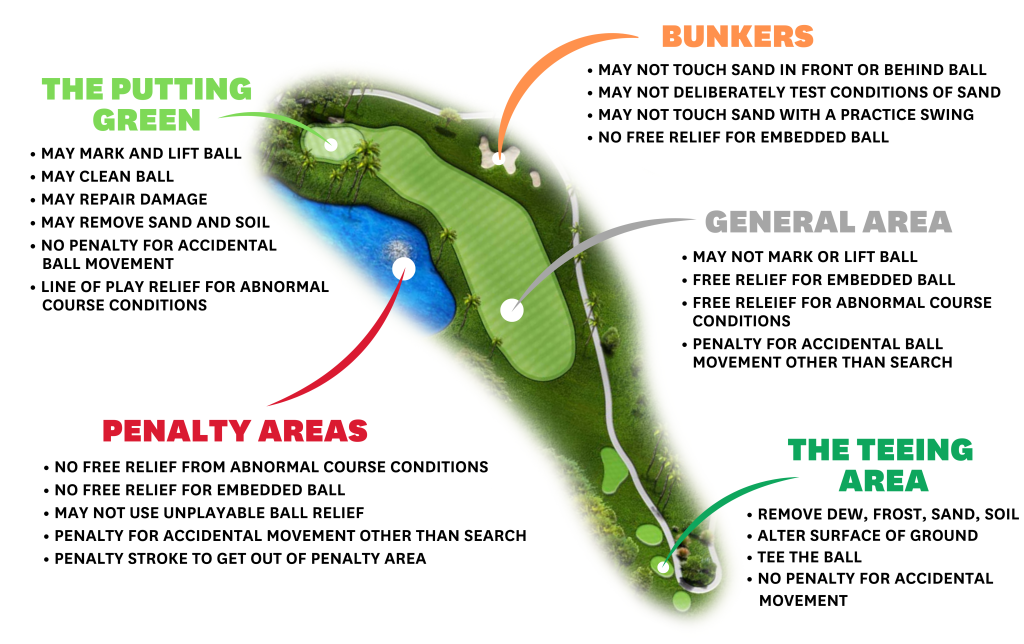Once the player knows where the ball lies, then they can figure out what options are available. The areas of the course are treated more or less favorably under the Rules and will give the player permission to do more or less with the ball and surrounding conditions depending on where it lies.
The Teeing Area: The teeing area is considered the most favorable area of the course. One reason for this is that generally, the ball is not in play yet so players are given the most leeway with what can be done.
- The ball can be teed in various ways and cuts the player slack for accidentally knocking the ball off the tee.
- Normally, players cannot remove dew and frost or create and eliminate irregularities of surface, however those restrictions do not apply when the ball is in the teeing area.
The Putting Green: The putting green is the next highly favored area of the course. It is the most highly prepared surface with the least amount of forgiveness for the final target – the hole.
- There are a number of specific permissions, including the ability to mark and lift the ball when it is on the putting green (and clean it) or to repair damage such as pitch marks and foot damage.
- There is no penalty for accidentally moving the ball or ball-marker on the putting green.
- Sand and loose soil are not loose impediments, however specific permission is given to remove sand or loose soil from the putting green.
- Line of play relief is allowed (in addition to physical interference) from abnormal course conditions that are on or off the putting green.
- Being on the putting green does come with some restriction as the player may not deliberately test the surface of the a green by rubbing the surface or rolling a ball (except on the last putting green played when between two holes).
General Area: The general area is in the middle of the favorability scale. It is treated better than bunkers and penalty areas, but there is not as much leeway as on the putting green.
- There is a penalty for accidentally moving the ball, including practice swings and while moving loose impediments (exception for movable obstructions).
- A player cannot improve the conditions affecting the stroke (lie, area of stance or swing, line of play or relief area) by various means that were otherwise allowed in the teeing area and on the putting green.
- Free relief is allowed for physical interference from abnormal course conditions and dangerous animal conditions, but not line of play relief.
Bunkers: Bunkers are still an area to be contended with, but they are considered a slightly better place to be than penalty areas.
- Players are allowed to touch sand in placing clubs, removing loose impediments or even striking the sand in anger, but there are some restrictions that come with playing the ball in a bunker.
- Players are not allowed to touch sand in the bunker before making a stroke to test the condition, in making a practice swing, in making your backswing for the stroke or in the area right near the ball.
- Free relief is allowed for physical interference from abnormal course conditions and dangerous animal conditions, but taking relief without penalty must stay in the bunker.
- Players can still declare the ball unplayable in a bunker, but relief must be taken inside the bunker except when proceeding under stroke and distance (and the previous spot is outside the bunker) or when getting two penalty strokes to take back-on-the-line relief outside the bunker.
Penalty Areas: Penalty areas are the harshest place the ball can end up that is actually on the course and the options are limited.
- When playing the ball as it lies in a penalty area, the player may remove loose impediments, ground their club and take practice swings, as if the ball were in the fairway. However there are some restrictions to be aware of.
- Free relief is not allowed for interference by an abnormal course condition or embedded ball if the ball is in a penalty area.
- A ball may not be treated as unplayable in a penalty area, players must use the options provided for relief from the penalty area.
- The only relief options to get out of a penalty area cost one penalty stroke to use.





